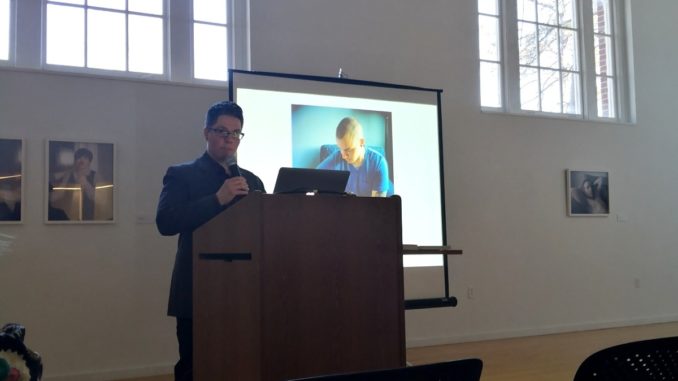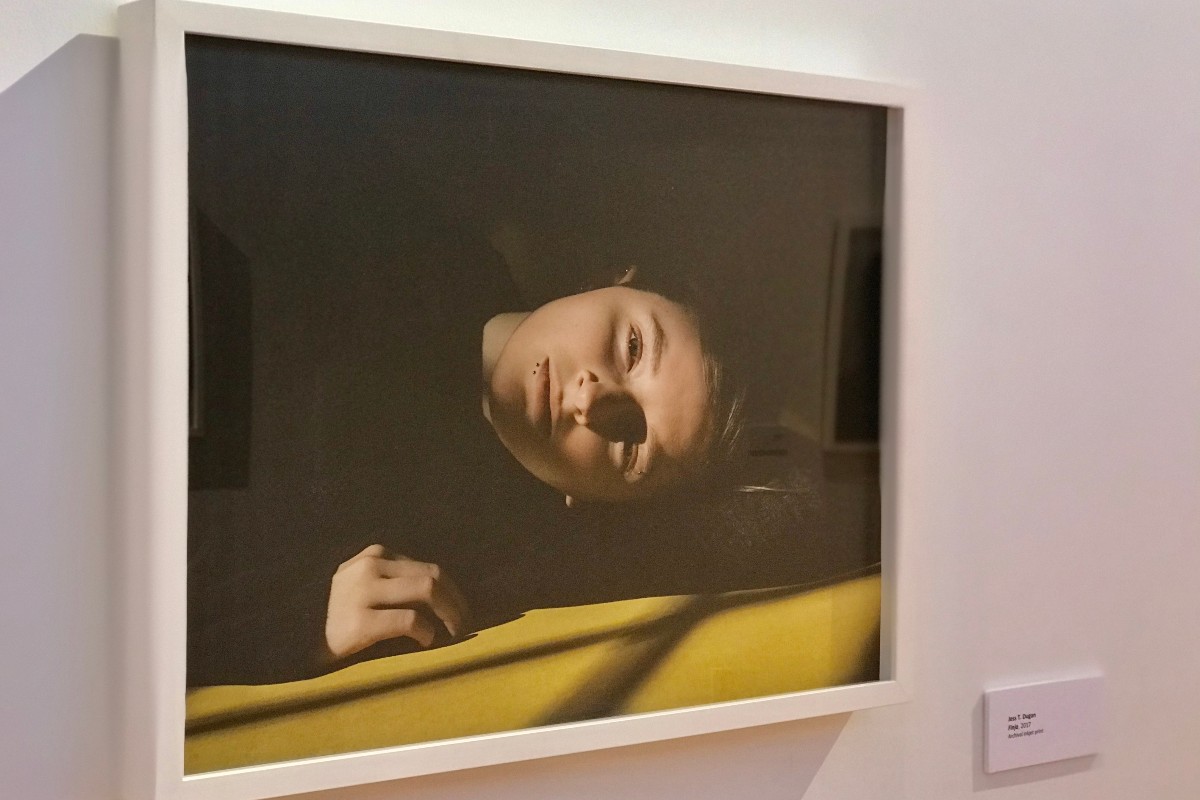
Contemplative eyes gaze ahead as the subject’s partner rests their chin on their shoulder. The aura of self acceptance is disclosed as one proudly holds their protruding stomach. A bare chest reveals scars from top surgery.
Photographer Jess T. Dugan is known for depicting these immensely intimate images in her work, which she brought to Truman State University’s art gallery last month.
In her keynote speech on Feb. 22, Dugan explained how she aims to use her pictures as a means of exchanging experience. Dugan sees her art as validating for those in the LGBTQ+ communities and educational for those outside.
“I believe really deeply in the power of storytelling and sharing your own truth,” Dugan said. “I’ve seen how powerful it can be to share an experience with others in a way that can be meaningful or validating to them, and that this sharing of your own experience can create space [for others] to also share theirs.”
Ophelia Parrish’s art gallery often displays work from Truman students as well as well-renowned or developing artists, which allows local and national works to be featured on campus. Dugan, a St. Louis native, was an addition that fell somewhere in between.
Heidi Cook, assistant art professor and University Art Gallery director, suggested that networking is crucial for planning these types of functions at the venue.
“I often rely on the connections that our faculty have,” Cook said. “Priya Kambli, who is a professor here at Truman, has known Jess for a while. She meets other young practicing photographers, so Priya was sort of our connection to Jess T. Dugan’s work. She had seen Jess’ work and had seen Jess give presentations before and was just really enamored with her work.”
Truman is able to utilize the space to showcase art derived from a wide variety of backgrounds. A primary objective of displaying Dugan’s exhibit was to represent as well as inform Truman and Kirksville populations.
Because these exhibits have the ability to evoke profound emotions from diverse viewpoints, Cook saw the event as an opportunity to spark discussion between an array of perspectives.
“The gallery’s mission is complex,” Cook said. “We not only serve the art department, but we serve the broader campus community and then we also hope to serve a broader northeast Missouri community. So when we think about all of those communities, we’re hoping to do two things that are kind of opposite. One is to hopefully help people see themselves reflected in the art, but then we also sometimes want to challenge people, too, and help people see perspectives that are maybe different than their own. I think Jess’ work can provide both of those for different communities.”
Though it portrays a multitude of themes and lifestyles, the exhibit is largely aimed toward members of the LGBTQ+ community. Cook reached out to several organizations on campus for gallery usage.
One such group was Prism: Truman State University’s Pride Alliance. The club convened at the gallery for “speed friending,” an icebreaker activity to unite LGBTQ+ students in a welcoming environment.
Sophomore Ian Rosebrough, Prism social relations chair, said the exhibit was highly impactful on a personal level.
“My first reaction was kind of like, ‘Good for you,’” Rosebrough said. “I think once I went in there I would definitely echo that sentiment. It was sort of like, ‘We did this. We got this far.’ That level of representation — It was almost, not quite pride, but in that same vein, I think.”
Cook said there has been good feedback from attendees of the talk as well as those who simply passed through the gallery. Favorable comments have generally stemmed from the impression of advocacy for underrepresented minorities that the exhibit gave.
Prism vice president Mika Zans said the event was effective in appropriately celebrating the groups it represented.
“It felt like a very genuine show of support,” Zans said. “It didn’t feel like, ‘Oh, well you’re here, I guess. We’re gonna just do this for you so that you don’t feel ignored,’ but it felt like, ‘We’re going to represent you through this.’”
Though accurate representation can be difficult to achieve, Dugan’s photographs revealed a comprehensive look at gender and sexuality for viewers to relate to and understand. These particularly struck a chord through the lens of LGBTQ+ students and faculty.
Zans suggested that this high engagement was perhaps because of the high level of authenticity conveyed.
“Seeing each picture definitely gave us the sense of a unique aspect to that individual,” Zans said. “They weren’t all just the same, ‘Oh, I’m going to make you look nice in this way and then take a picture of you so it looks nice.’ They all felt very individual to each person.”
Rosebrough further reflected that seeing the LGBTQ+ community represented in a high art context seemed a bit out of place initially. Through discussion, however, the group saw how unfortunate that realization might have been.
Dugan’s deep humanization of photographed subjects led to greater connection among all who came in contact, Rosebrough suggested.
“I think a lot of people’s reaction was just that human connection, that human feel when you look at the pieces — sort of the complexity of that person, that there’s an entire individual there,” Rosebrough said. “What’s the word? Sonder … the realization that all people have a life as complex as yours. I feel like that was the feeling wandering through the gallery.”
The event was also extended to include the Center for Diversity & Inclusion as well as the Women and Gender Studies faculty to broaden its scope. In effect, several other functions were able to be held at the gallery, including Safe Zone training to teach methods of inclusivity and how to support the LGBTQ+ community.
Cook said these collaborations also facilitated higher coverage via cross advertising and better integrated departments.
“There were a lot of really positive responses to the conference,” Cook remarked. “I think sometimes it’s hard to get people from outside the art department to come to events because they’re perceived as only for the art department. Partnering with Women and Gender Studies was good because it made the event advertised to other departments, and I think made it more interdisciplinary.”
It was important to Cook for the exhibit to encompass a mixture of representation and education, which was carried out through this variety of mediums. In pondering the event’s success, Cook thought back to its original purpose.
“I hope people feel like this is a welcoming space that embraces queerness in all of its many forms,” Cook said.


